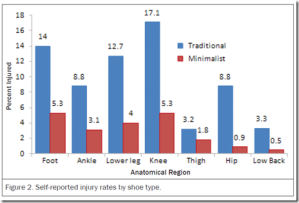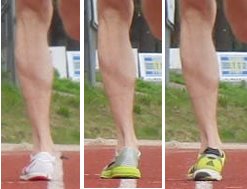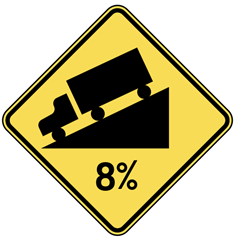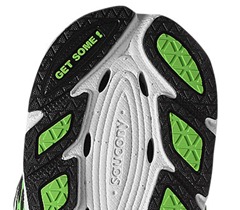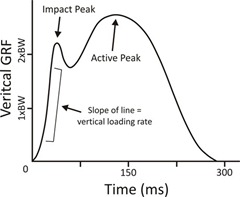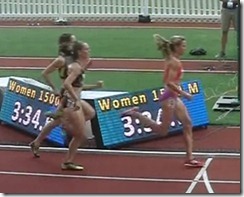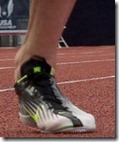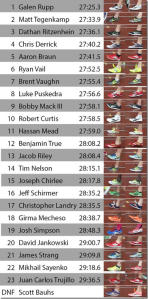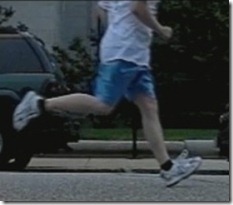Last week a flurry of articles appeared linking to the abstract of a new survey based study that suggested that traditionally shod runners are 3.41 times more likely to suffer a running-related injury than minimally shod runners. I opted to hold off on posting anything about the study until I had a chance to read […]
Do Runner’s Know Their Arch Height and Amount of Pronation, and Does it Matter?: Study #2
Last week I posted the results of a study published in a conference proceedings back in 2003 that addressed the question of whether runners’ self-assessment of their degree of pronation was accurate or not (i.e., do they know if they overpronate). Their conclusion was that most runners have very poor knowledge of how much they […]
Do Runners Really Know How Much They Pronate?
Two days ago I posted commentary on an article by podiatrist Ian Griffiths that discussed why the term “overpronation” is inaccurately applied and should be banished as a blanket criterion for assigning shoes to runners. I did quite a bit of research on this topic while writing my book, and my overwhelming conclusion was that […]
Why the Term Overpronation Should be Banished: Great Article by Podiatrist Ian Griffiths
Question: Why do you wear pronation control shoes? Answer: Because someone at a shoe store told you that you need them, and they were told that you need them by a shoe company rep. The above Q&A basically describes my feelings on the topic of overpronation. You might think that you wear such shoes because […]
Heel-Forefoot Drop, Foot Length, and Ramp Angle: How Shoes Alter the Orientation of Your Feet
Over two years ago I wrote a post on what exactly is meant by the phrase “heel-toe drop,” and that post remains one of the most frequently read on this blog. Put quite simply, drop is the difference in height between the base of the heel and the ball of the foot when standing in […]
On Running Shoe Wear and Outsole Durability
Shoe wear patterns fascinate me. At the end of each run, I have the habit of taking my shoes off and scrutinizing my sole wear patterns to see if anything interesting pops up. I may look a bit odd walking down my street barefoot while staring at the soles of my shoes, but at this […]
My VO2max Test Results: Running to Exhaustion!
This afternoon I completed my first ever VO2max test. The test is something I’ve taught about in my Exercise Physiology class, but until today I’d never actually done one myself, so it was with a great deal of excitement that I drove the hour from my campus to the exercise physiology lab at the University […]
Study: Impact Loading Rate in Running Reduced by Adopting a Midfoot Strike
A new study was just published in the European Journal of Applied Physiology that showed that adopting a midfoot strike is an effective way to reduce the impact loading rate during running. The study was conducted by a group from France and Canada (including my friend Blaise Dubois) and is titled “Impact reduction during running: […]
“Research Isn’t Everything…” – Great Post By Physiotherapist Tom Goom
If there’s one thing I’ve learned over the past few years it’s that both research and individual experience (yes, anecdotal evidence!) can be equally valuable sources of information when attempting to make decisions about which type of shoe to wear, whether or not to change your running form, which training methods to employ, etc. In […]
Study Examines Breast Movement During Bare-Breasted Running
A few days ago I received a literature review update from my friend Blaise Dubois, and among the many articles he summarized was one in particular that caught my eye. The article from the July 2012 issue of Medicine & Science in Sport & Exercise is titled “Predictors of Three-Dimensional Breast Kinematics during Bare-Breasted Running.” […]
Slow Motion Videos of Runners at the 2012 US Olympic Trials: 1500 and 5000 Meter Women’s and Men’s Races
Below are an excellent series of videos shot with a high-speed video camera by PT Jeff Moreno from Precision Physical Therapy and Fitness in Santa Cruz, CA. While you watch the videos, which Jeff originally posted on his clinic’s blog, keep an eye on the landing position of the foot relative to the knee at […]
Images of Galen Rupp’s Foot Strike at the 2012 US Olympic Trials
Below are a few more great image compilations produced by biomechanist Iain Hunter of Brigham Young University. The first shows Galen Rupp’s foot strike from the front during his victory in the finals of the US Olympic Trials 5k race. It’s incredible to look at the range of supination to pronation (in the colloquial usage […]
Foot strike Patterns of Men and Women at the US Olympic 10K Trials
A few days ago Steve Magness, assistant coach at the Nike Oregon Project, directed me to a couple of images that BYU biomechanist Iain Hunter had put together showing foot strikes of Men and Women at the US Olympic 10K trials. In case you have not seen them yet, I thought I’d share them here […]
How Leg Muscle Activity Changes as Running Step Rate is Increased
There has been a great deal of discussion and debate over the past few years about how various aspects of running form can potentially contribute to increased injury risk in runners. One aspect of form that is often singled out as a major no-no is overstriding. That is, runners should not lengthen their stride by […]

